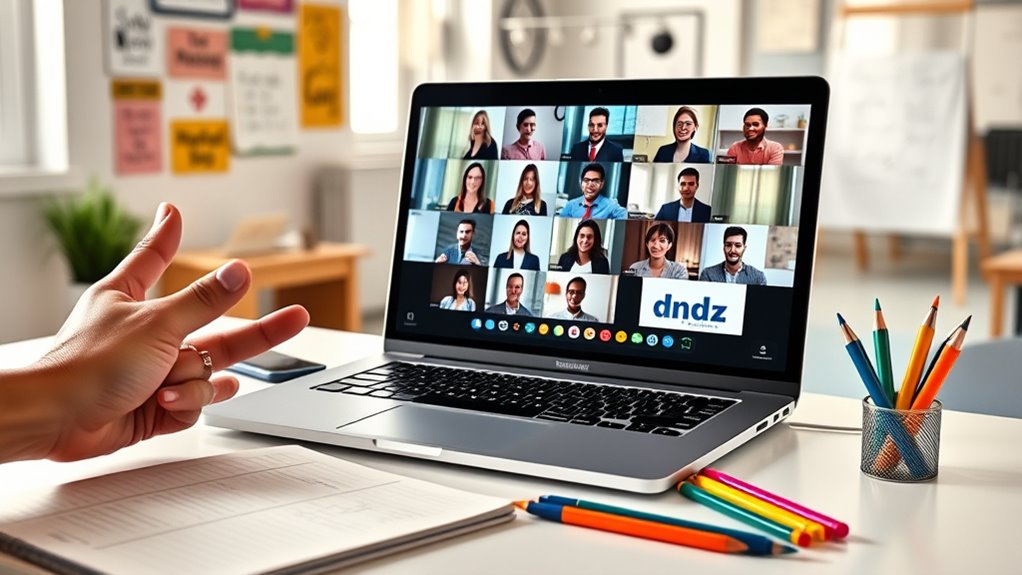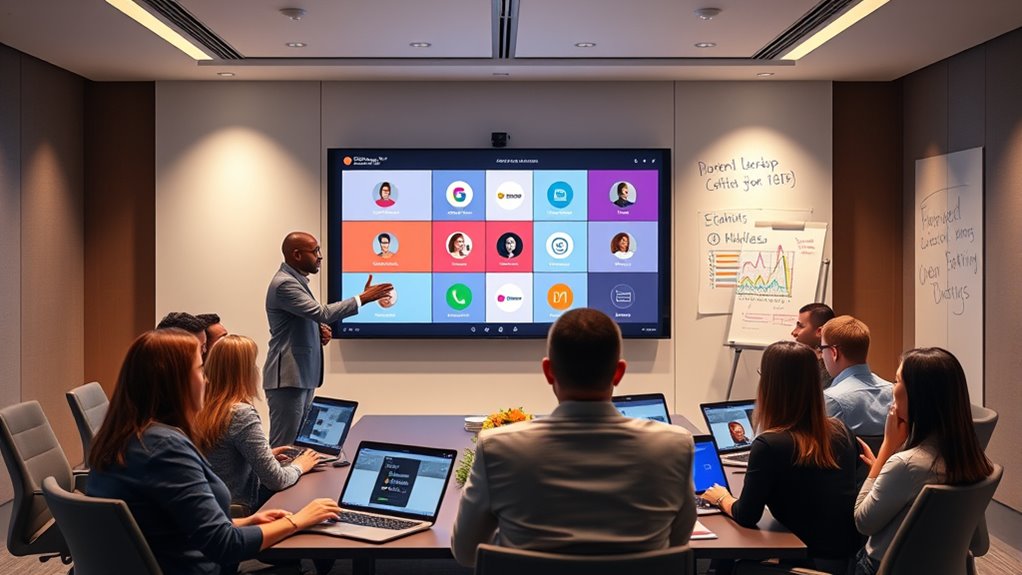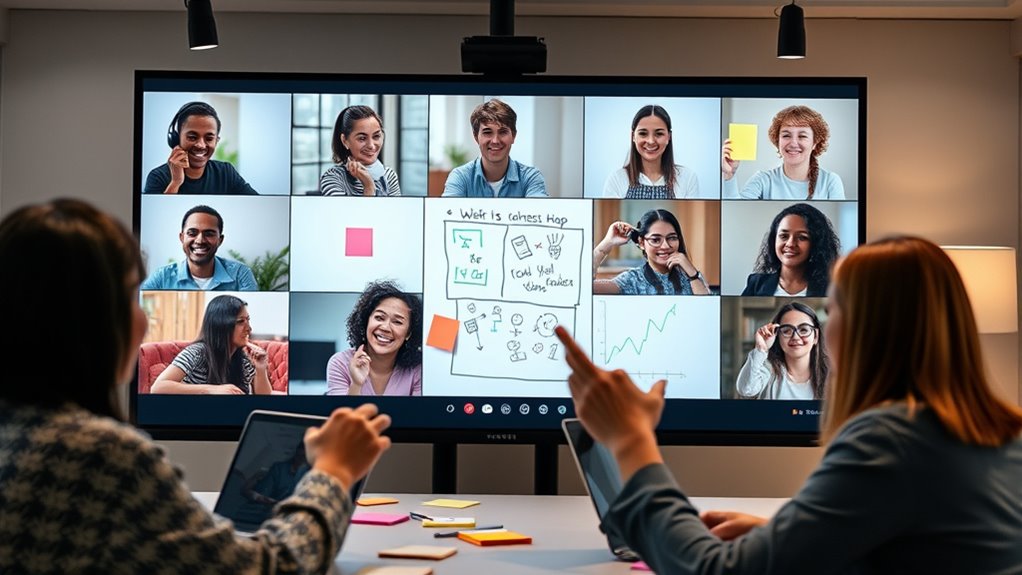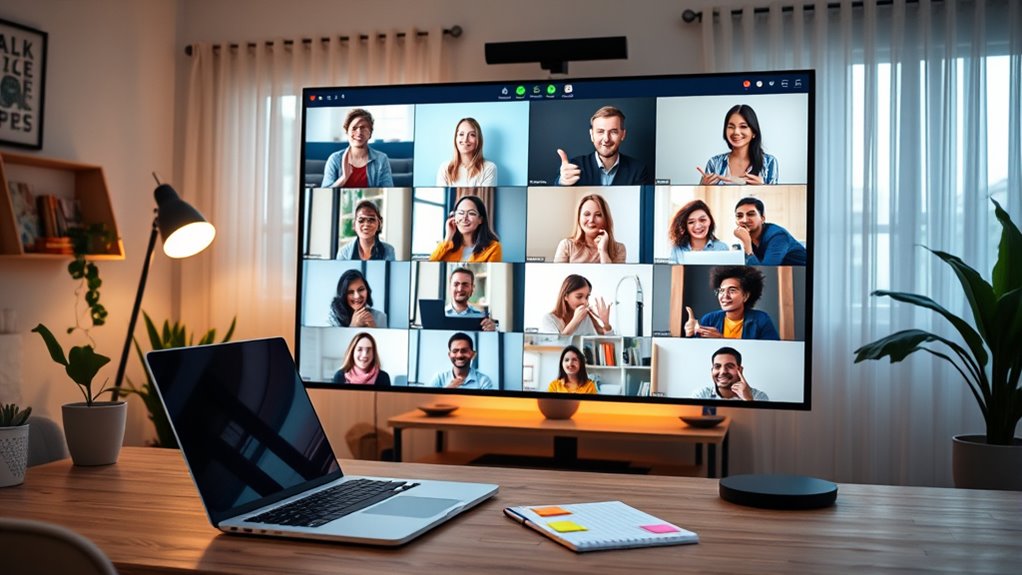To facilitate engaging virtual workshops, start by setting clear goals and communicating roles upfront. Choose user-friendly platforms with features like breakout rooms and polls, and incorporate multimedia to keep participants interested. Design inclusive activities that encourage participation, such as polls, reflection, and collaborative tasks. Manage time effectively with breaks and visual cues, and gather feedback to improve future sessions. Keep energy high and foster a supportive atmosphere—continue exploring to access even more strategies for success.
Key Takeaways
- Clearly define goals, roles, and outcomes upfront to align participants and set expectations for engagement.
- Choose user-friendly, feature-rich platforms with collaboration tools like breakout rooms and polls to enhance interaction.
- Incorporate varied, interactive activities such as gamification, reflection, and multimedia to sustain interest.
- Manage session flow with timed activities, strategic breaks, and energizers to maintain focus and prevent fatigue.
- Collect and analyze feedback post-session to continuously improve engagement strategies and foster a supportive environment.
Setting Clear Objectives and Expectations

To guarantee your virtual workshop runs smoothly, it’s essential to set clear objectives and expectations from the start. Achieving goal clarity ensures everyone understands what’s to be accomplished, reducing confusion and keeping the session focused. When you clearly communicate your expectations, participants know how to engage and contribute effectively. Expectation setting involves outlining roles, participation guidelines, and desired outcomes early on. This process can also include sharing desired outcomes, so all participants are aligned on the intended results. This clarity helps prevent misunderstandings and keeps the workshop aligned with its purpose. Take time at the beginning to define specific goals and be transparent about what you expect from attendees. When everyone is on the same page, the workshop becomes more productive, engaging, and successful. Clear objectives and expectations set the foundation for a seamless virtual experience.
Choosing the Right Technology Platform

Selecting the appropriate technology platform is essential for the success of your virtual workshop, as it directly impacts how participants engage and collaborate. Focus on platform features like breakout rooms, chat, and polling to keep everyone involved. User accessibility is equally important; choose a platform that’s easy to navigate for all participants, regardless of technical skill. To help you evaluate options, consider this comparison:
| Platform Features | User Accessibility |
|---|---|
| Interactive tools | Intuitive interface |
| Collaboration options | Compatibility |
| Recording and sharing | Device flexibility |
| Support for diverse user needs | Accessibility features |
Effective selection can also benefit from understanding regional resources that offer tailored guidance.
Designing Interactive and Inclusive Content

Creating interactive and inclusive content is essential for engaging all participants and ensuring meaningful collaboration. Use gamification techniques to make activities more engaging, such as quizzes, badges, or point systems that motivate participation. These strategies foster a sense of achievement and friendly competition. Additionally, consider accessibility considerations to guarantee everyone can fully participate. Use clear language, caption videos, and provide alternative formats for visual or auditory content. Design content that accommodates diverse needs, including those with disabilities or language barriers. Keep instructions simple and concise to avoid confusion. Incorporating self-awareness into your workshop activities can help participants better understand themselves and relate more effectively to others. By combining gamification techniques with accessibility considerations, you create a dynamic environment where all attendees feel valued, involved, and motivated to contribute actively throughout your virtual workshop.
Incorporating Engaging Activities and Breakout Sessions

To keep your participants engaged, incorporate interactive group activities that encourage collaboration and participation. Using dynamic breakout strategies can help you facilitate smaller discussions and build connections. These approaches make your virtual workshop more lively and effective for everyone involved. Incorporating engaging activities that cater to diverse learning styles can further enhance participant involvement and retention.
Interactive Group Activities
Engaging participants in interactive activities and breakout sessions can considerably boost the effectiveness of your virtual workshops. You’ll want to incorporate a mix of engaging strategies to keep energy high and minds active. Start with lively icebreaker activities to build rapport quickly. Use gamified exercises to motivate participation and add a competitive edge. Incorporate collaborative tasks that require teamwork, fostering connection among attendees. Vary the formats to maintain interest, such as polls or quick challenges. Finally, encourage reflection and sharing through short group discussions. These approaches create a dynamic environment that promotes active engagement and sustains focus. Incorporating essential oils for engagement and relaxation can also help set a positive tone, making your sessions more inviting. By thoughtfully integrating these interactive group activities, you make your virtual workshops more memorable and impactful for everyone involved.
Dynamic Breakout Strategies
Have you considered how dynamic breakout strategies can elevate your virtual workshops? By designing activities that encourage peer-to-peer interactions, you foster genuine engagement and collaboration. Incorporate spontaneous conversations by assigning open-ended prompts or problem-solving tasks that require participants to think on their feet. Use varied breakout formats, like quick brainstorms or themed discussions, to keep energy high and participants involved. Rotate group compositions to maximize diverse perspectives and prevent stagnation. Encourage participants to share insights afterward, reinforcing their active involvement. These strategies create a lively environment where spontaneous conversations thrive, making your virtual workshop more memorable and impactful. When you intentionally design breakout sessions with engagement in mind, you’ll see increased participation and richer interactions. Additionally, considering security vulnerabilities in your planning can help ensure a safe and trustworthy environment for all participants.
Utilizing Visuals and Multimedia to Enhance Engagement

In virtual workshops, visuals and multimedia are powerful tools that can substantially boost participant engagement. They help you communicate ideas more clearly and keep your audience interested through dynamic content. By leveraging visual storytelling, you make complex concepts memorable and relatable. Multimedia integration also adds variety, preventing monotony and encouraging attention. To maximize impact, consider these strategies:
- Use compelling images and infographics to illustrate key points
- Incorporate short videos to demonstrate concepts or share stories
- Embed interactive slides for real-time engagement
- Mix text, visuals, and audio to cater to different learning styles
- Keep multimedia concise and relevant to maintain focus
- Incorporate high refresh rates to ensure smooth visuals and reduce distractions during presentations
These elements keep your workshop lively, help your audience retain information, and foster a more immersive experience.
Encouraging Active Participation and Collaboration

To foster active participation and collaboration in virtual workshops, you need to create an environment that encourages interaction and values each participant’s input. Start with icebreaker games to break down barriers and energize the group. Use collaborative tools like shared documents or digital whiteboards to facilitate real-time teamwork. These tools make it easy for everyone to contribute and stay engaged. Encourage open dialogue by asking questions and inviting feedback regularly. Assigning small group tasks can boost interaction and deepen collaboration. Additionally, monitoring the expiration of shared resources or tools can prevent disruptions during the session. Below is a helpful table highlighting key strategies:
| Strategy | Tool/Activity | Purpose |
|---|---|---|
| Icebreaker games | Virtual quizzes | Build rapport and relax participants |
| Collaborative tools | Shared documents | Enable real-time collaboration |
| Small group tasks | Breakout sessions | Foster teamwork and engagement |
| Regular check-ins | Polls and surveys | Gather feedback and promote dialogue |
| Clear expectations | Guidelines and prompts | Keep participation on track |
Managing Time Effectively to Maintain Momentum

To keep your virtual workshop on track, setting clear time limits for each activity helps participants stay focused. Incorporate strategic breaks to re-energize the group and prevent fatigue. By managing your schedule effectively, you’ll maintain momentum and guarantee productive discussions. Additionally, understanding the types of divorce can help tailor your content to address specific participant concerns at appropriate times.
Set Clear Time Limits
Setting clear time limits for each segment of your virtual workshop helps keep participants engaged and makes sure you cover all your key points. It creates a sense of urgency and maintains momentum. Use timed icebreakers to energize the group early on, but keep them brief to avoid dragging. Incorporate time-boxed exercises to ensure discussions stay focused and productive. Be explicit about how long each activity lasts, and stick to those limits to prevent spillover. Consider using visual timers or countdowns to remind everyone of remaining time. This approach helps participants stay on track and engaged throughout. Clear time boundaries also make smooth transitions, keeping your workshop dynamic and efficient. Additionally, setting boundaries around discussion topics can prevent tangents and keep the session streamlined.
Use Breaks Strategically
Have you considered how well-timed breaks can boost your workshop’s momentum? Incorporating mindful pauses allows participants to recharge and refocus. Schedule short breaks strategically, especially after intensive discussions or activities, to prevent fatigue. Use these moments for quick energy boosts—stretching, grabbing water, or just taking a deep breath. These mindful pauses help participants stay engaged and attentive throughout the session. Avoid long, unplanned breaks that can disrupt flow; instead, plan them intentionally to maximize their impact. Remember, well-placed breaks give everyone a chance to process information and reset mentally. Incorporating Gold IRA concepts into your break strategy can also inspire future investment discussions. When used effectively, breaks become a powerful tool to maintain energy levels, foster participation, and keep your virtual workshop lively and engaging from start to finish.
Gathering Feedback and Reflecting for Improvement

Gathering feedback and reflecting for improvement are essential steps in enhancing your virtual workshops. By collecting honest input, you can identify what worked and what needs adjustment. Using anonymous feedback encourages participants to share openly, providing valuable insights without hesitation. This process enables you to implement iterative refinement, continuously improving your facilitation methods. To make the most of this, consider these strategies:
- Distribute quick surveys after each session
- Encourage open-ended comments for detailed insights
- Analyze patterns in participant responses
- Adjust your approach based on feedback
- Reassess and refine your techniques regularly
- Ensuring privacy and cookie management can help maintain participant trust and transparency in your feedback collection process.
Building a Supportive and Energized Virtual Environment

How can you create a virtual environment that feels supportive and energizing for all participants? Start by incorporating virtual icebreakers that encourage openness and fun, helping everyone feel more comfortable. These activities foster an emotional connection, breaking down barriers and building trust early on. Keep energy levels high by mixing quick, interactive exercises with meaningful discussions. Use inclusive language and acknowledge everyone’s contributions to promote a sense of belonging. Encourage participants to share personal stories or insights, strengthening emotional bonds. When people feel connected and supported, engagement naturally increases. Remember, a positive atmosphere doesn’t happen by chance; it’s built through intentional activities and genuine interactions that energize your virtual space. Incorporating elements of jet boat design, such as streamlined communication and smooth transitions, can also enhance the overall flow and effectiveness of your workshops.
Frequently Asked Questions
How Can I Handle Technical Difficulties During the Workshop?
When you face technical difficulties during a workshop, stay calm and act quickly. Troubleshooting software involves checking your internet connection, restarting the program, or updating software. Always have backup plans ready, like alternative communication channels or offline activities, to keep the session running smoothly. You can also prepare a troubleshooting guide beforehand, so you know how to handle common issues and minimize disruptions for your participants.
What Strategies Promote Participation From Shy or Reserved Attendees?
Your workshop can feel like a bustling city, but shy attendees might stay in the shadows. To encourage participation, try icebreaker activities that are light and fun, helping them feel more comfortable. Use anonymous polling to let reserved participants share opinions without pressure. These strategies open doors for shy attendees to engage at their own pace, transforming quiet corners into lively conversations and ensuring everyone feels heard and valued.
How Do I Ensure Accessibility for All Participants?
To guarantee accessibility for all participants, focus on inclusive design by incorporating clear visuals, captions, and easy navigation. Use assistive technology like screen readers and adjustable fonts to support diverse needs. Make sure your platform is compatible with various devices and provide alternative formats for materials. By proactively addressing these elements, you create an inclusive environment where everyone can participate fully and comfortably.
What Are Effective Ways to Manage Large Virtual Groups?
Managing large virtual groups can be challenging, but you can make it smoother by incorporating icebreaker activities to build rapport early on. Use breakout sessions to divide participants into smaller, manageable groups for more active participation. Keep track of time and encourage interaction through chat or polls. These strategies help maintain engagement, foster collaboration, and guarantee everyone feels involved, making your virtual experience more effective and enjoyable.
How Can I Sustain Engagement Over Multi-Day Virtual Workshops?
Imagine your workshop as a lively garden that needs daily care. To sustain engagement over multiple days, you plant seeds with icebreaker activities to build trust early on. Keep the soil fertile with interactive polling, encouraging participation. Regularly refresh content and recognize contributions, like watering your plants. This consistent nurturing keeps your virtual garden vibrant, ensuring attendees stay involved, motivated, and enthusiastic to grow together throughout the entire workshop.
Conclusion
By applying these strategies, you turn virtual workshops into vibrant hubs of engagement. Remember, a well-designed session is like a spark—igniting curiosity and connection. When you set clear goals, choose the right tools, and foster active participation, you create an environment where everyone feels valued and energized. So, embrace these tips and watch your virtual workshops flourish—because engaging others isn’t just an option, it’s your secret to success.








